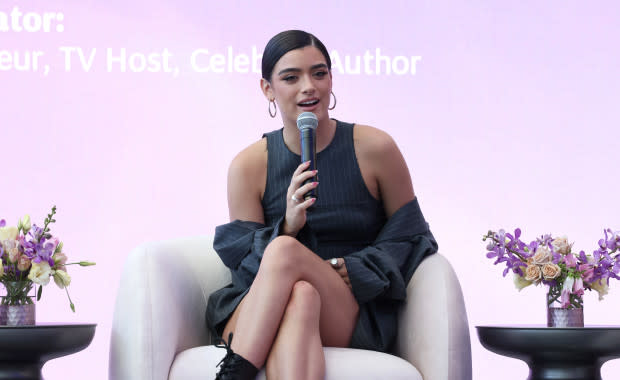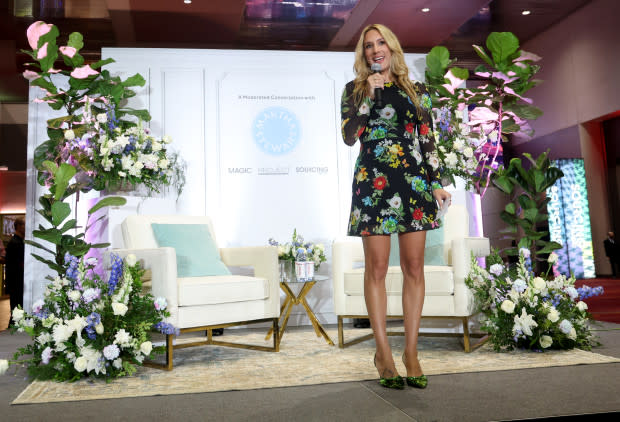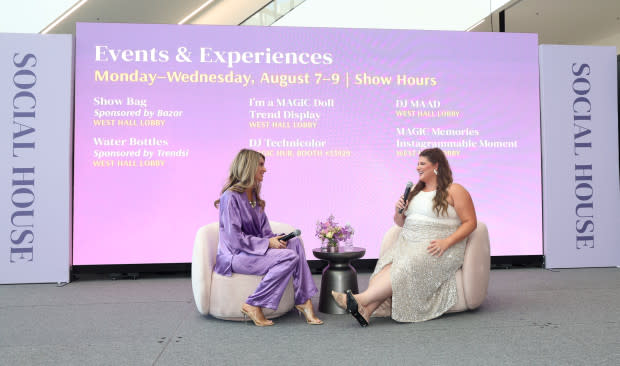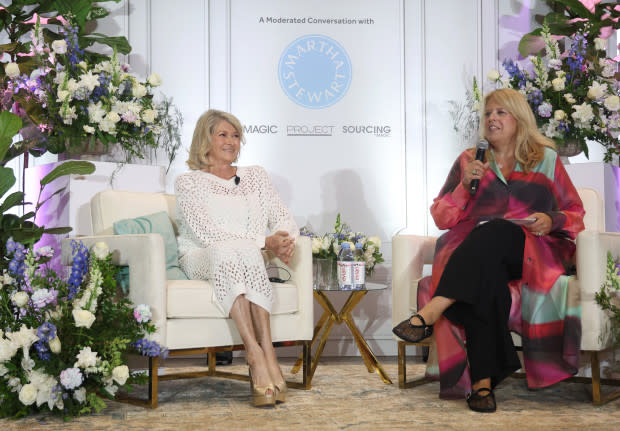How OG Fashion Trade Shows Are Adapting to Industry Shifts

Photo: Gabe Ginsberg/Getty Images
It's an era of change for the humble trade show, and perhaps it's a long time coming.
As far as mainstay industry gatherings go, fashion trade shows have not been subject to the same widespread public fascination as fashion weeks, and have thus remained relatively behind-the-scenes (but still crucial) events, even as runway shows have evolved into glamorous-looking publicity stunts that target consumers as much as they do editors, buyers and other industry insiders. As a result, they've largely stuck to their B2B roots, simply providing a space for brands to showcase their latest wares to buyers, and for buyers to discover them and write orders for the upcoming season, all in one place. But this, too, is starting to change as trade shows (like most businesses in existence) fight for relevance amid industry upheaval. And there may be no better case study than the well-established MAGIC in Las Vegas, the latest of which took place this month.
First, a little background: MAGIC (an acronym for Men's Apparel Guild in California) was established in Palm Springs in 1934 as a non-profit menswear show. It has since expanded to include womenswear, accessories, small gifts and even manufacturing services, the latter of which now occupy their own hall, dubbed Sourcing at MAGIC. Also in its own hall is Project, which highlights contemporary womenswear, unisex and a large of offering streetwear-leaning menswear brands.
Though the overall event has expanded, MAGIC occupies the largest of the three halls by far, playing host to an abundance of mass-market womenswear brands targeting younger customers (i.e. Gen Z) — the sort you might find at Macy's or Urban Outfitters. It's been held twice yearly in Las Vegas since 1989, and there's also a biannual New York iteration that takes place shortly after New York Fashion Week. The majority of those who register to attend are buyers; 56% work for boutiques with a signle store, the rest for larger retailers like Nordstrom, Free People, ASOS and Lulu's.
Obviously, the event has come a long way in the past 90 years, but recent industry shifts (and the Covid-19 pandemic) have accelerated its evolution even further. With the rise of direct-to-consumer business models and digital wholesale platforms, attending IRL trade shows — especially those taking place in the middle of the desert in August — is far less necessary than it used to be. Meanwhile, factors like sustainability, inclusive sizing and diverse representation have grown increasingly important to buyers as they consider their seasonal assortments.

Photo: Gabe Ginsberg/Getty Images
Kelly Helfman, president of Informa Markets Fashion (which organizes MAGIC, Project, Coterie and other trade events throughout the year), and her team take it upon themselves to ensure they are meeting buyers' and retailers' ever-changing needs while planning each of the 14 events they oversee.
"What we're all about at the core doesn't really change, right? We're bringing buyers and sellers together to power the wholesale fashion industry," Helfman explains. "But what this looked like when I first started in 2006 to today, 17 years later — I mean, it's incredible."
Everything from who gets invited to the curation of brands to the event's overall feel and experience has evolved. Below, Helfman fills us in on the biggest ways MAGIC is changing to meet the moment, how her metrics for success have changed and what the trade show might look like a few years from now.
Adapting to new ways of buying
The traditional seasonal buying calendar has fallen out of favor for too many reasons to count — shopping habits, climate change, travel, waste, discounting and supply-chain issues are a few. There's a growing desire among retailers to fill inventory as needed for more of a "buy now, wear now" approach.
"How retailers shop now versus 10 years ago is incredibly different," says Helfman. "They do want to fill inventory on demand and have a little bit less inventory risk; that goes with the fact that they don't want to be wasteful. It's then changed the cycle on how these brands produce based on how the buyers are now shopping. And that affects [when we show to make] sure we show up on the right dates, to be able to supply at the right timing for them to shop, because we don't just have this show, we have another nine."
Meeting demand for sustainability — without greenwashing
While the majority of the brands I saw at MAGIC appeared to be mass-produced, sustainability was the focus of many of the exhibitors at Sourcing, and it's becoming a bigger priority for all the trade shows: For both Project and Sourcing, companies that want to present themselves as sustainable must now first go through a vetting process created in partnership with Hey Social Good. (This program will be rolled out to MAGIC in the future, I'm told.)
"A lot of the brands will say, 'We're sustainable.' They want us to market them that way. And you know what? They are doing something, but it's important that we're clear and doing the work and capturing the data to make sure that, if we're gonna market you that way to these buyers that are looking specifically for sustainable brands, we can get behind that and say, 'They are doing X, Y and Z,'" says Helfman.
"We ask them, when they sign up with us to be an exhibitor, all these questions: Do you get behind the UN standards? What are you doing here in terms of manufacturing? What types of fabric? Then we give it to a third-party company that helps support us, to verify the data and what they're saying. That's a lengthy process that takes weeks, sometimes months... It's an ongoing process to help these brands understand what it really means to be sustainable. Some are much more advanced than others. With the consumer trends changing and the new generation demanding to have more transparency, we have to be able to do this for our community, to be able to serve the appropriate information. Their consumers are demanding it, especially the ones that cater to towards the younger demographic."

Photo: Gabe Ginsberg/Getty Images
Building a more inclusive brand offering
In addition to sustainability, inclusivity is also a growing priority, and Helfman and her team are working to incorporate more women-owned, Black-owned and extended-sizing brands into their offering.
This season, of the 743 brands that showed at MAGIC Women's, only four — less than 1% — were Black-owned; 13% billed themselves as "sustainable"; 17% offered "plus" or "special" sizing; 22% were women-owned. Of the 258 brands that showed under Project Women's, 1% were Black-owned; 41% billed themselves as "sustainable"; 14% offered "plus" or "special" sizing; 29% were women-owned.
"These are things that we actually seek out and curate and that we stand by as an organization, where 15 years ago, we were kind of talking about it and having these conversations, but it wasn't something that we were implementing and being really intentional about when we create the assortment on our show floor," explains Helfman.
Creating ROI with experiences and content-creation opportunities
If content wasn't created, did the event even happen? The Las Vegas Convention Center was rife with social-media opportunities: hair and makeup touch-up stations, tooth gems, an array of "Instagrammable Moments" and meet-and-greets with celebs and influencers like Remi Bader and Dixie D'Amelio, who also participated in one of several on-site panel discussions — part of an effort to provide "educational" experiences to visitors as well.
Subjects of these talks included trend forecasting, styling, AI and social media. TikTok also hosted its own panel to introduce its new Shop feature; the platform also set up a booth on the MAGIC floor and hosted live selling sessions with creators, which anyone could watch and observe.
"The focus on education and content experience... it's always been an exciting part of our trade shows and MAGIC. But it's that much more inspirational for our attendees now," says Helfman. "They look to us to be inspired on what to do in their retail stores, how to do a fun popup that's experiential to add value for their shoppers, styling tips. They want resources there. So the education/resource/experiential part has become so much more robust."
"Fifteen years ago it was really about order writing and people coming to launch brands, which is all still the majority of what we do today — but there's so much more to give it that festival-like, content-driven model," she continues. "They get to have a lot of fun along the way with all the celebrities, touching and feeling the product. You can't replace that through a digital platform."
Expanding the invite list
In addition to the usual suspects — sales reps, buyers — Helfman is increasingly focused on inviting influencers, costume designers, stylists and more to create a wider networking opportunity and cater to different kinds of needs.
"We didn't have, 20 years ago, the influencer program we have now," explains Helf. "So not only are we helping these brands with their wholesale model, but by bringing influencers and stylists here, we're helping them with their consumer-facing brand as well."
"We're not going to deny the fact that people need to have diversification of revenue when they have a brand or a boutique," she adds. "How do we really address that and say, 'There's the B2B model, there's the D2C model, here's all the things you could be doing based on whatever your priorities are.'"

Photo: Gabe Ginsberg/Getty Images
The growth of 'Sourcing'
Sourcing — a huge exhibit of vendors, manufacturers, logistics companies, technology platforms and many other B2B resources — is now in its 20th year. It's an important part of MAGIC's future, largely reflecting industry evolution.
"It's one of our largest businesses for Informa Market Fashion. And it's where I think a lot of the innovation happens," says Helfman. "How that business has evolved has been incredible because now there's a huge sustainability area. We have a whole educational stream on sustainability, a different education stream for emerging designers and one for the larger buyers that could be the sourcing director for Savage X Fenty by Rihanna or for Tory Burch. We're constantly collecting data and surveying our community to understand what those needs are, so we're matchmaking them appropriately and evolving the offering of what we do based on how quickly this market changes."
MAGIC's 'festival-like' future
"I think for Las Vegas specifically, it's going to continuously become an industry event, where it's not just about wholesale, multi-brand shop owners and traditional brands; where we're connecting more and more influencers, stylists and and really leaning into that as things are changing and we create different models to support their business needs," Helfman predicts. "I also think there's going to be more festival-like fun: more keynotes, more education, more resources."
"Curation is key as the trends change," she says. "We never had home, gift and beauty — that's now a really big part of our MAGIC forum. So, focusing constantly on what's hot and what's coming out and making sure we have those offerings. We've got to be five, 10 steps ahead. I want to make sure that [buyers] come out of here with so much ROI and so much value. That's what keeps me up at night, making sure I'm offering this incredible event where they were like, 'Wow, I met 20 new brands, I bought from these noteworthy brands, I got this education, this experience.'"
Disclosure: Informa Markets paid for my travel and accommodations to attend MAGIC Las Vegas.
Never miss the latest fashion industry news. Sign up for the Fashionista daily newsletter.
